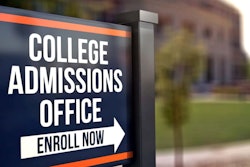Working Recruitment Miracles
Colleges and Universities in California and Texas Regroup, Rethink and Redouble Their Minority Student Recruitment Efforts
HOUSTON — Graduates of Worthing High School, a predominantly Black school here in the nation’s fourth-largest city, have gone on to become everything from Ivy Leaguers to Texas A&M Aggies.
But no one here ever gave much thought to attending the University of Texas-Austin until university officials visited the school last year. “This is the first time that a major predominantly White university has done this,” says Worthing’s principal, Ronnie C. Evans Sr.
Colleges and universities here in Texas and in California, two state’s whose reputations took a bruising because of anti-affirmative action measures, have had to regroup, rethink and redouble their efforts to recruit minority students reluctant to step into what could be perceived as an environment hostile to them.
While the 1998 California voter initiative and 1997 Texas court case that ended the use of race in admissions did cause minority applications and enrollments to plummet, college officials say they’ve recovered from those setbacks for the most part.
Though several public colleges and universities in those states have seen ripple affects from the anti-affirmative action measures, the struggle to boost minority enrollment has been most pronounced at the biggest, most selective schools.
Larry Burt, the University of Texas-Austin’s director of student financial services, says that university officials were able to snag several Worthing students because of the site visits to Houston and a new scholarship fund.
“We got eight students,” he says almost boastfully. “The number of Worthing students here [at the University of Texas-t Austin] went up from zero.”
Getting the Numbers Up
In fact, Texas officials say their efforts have been so successful that the freshman class that started in August includes more minority students than at any time before the controversial Hopwood case was even conceived.
At the University of California system, where the most selective campuses are located in Berkeley, Los Angeles and San Diego, university administrators say they are pleased with the small increase in minority freshman enrollment this year.
It is because institutions have been so aggressive in finding alternative ways to diversify their student bodies that backers of affirmative action say they once again are optimistic that more minority students will be on campus.
“I was disturbed by Hopwood but not discouraged,” says Evans. “I knew that if people were really colorblind, they were going to find a way to make sure our children were going to get what had been denied them through no fault of their own for so long.
“I’m saying there are some colorblind White brothers and sisters out there who have no qualms about a person’s color,” Evans adds, “but are just concerned about a person’s mind.”
Dr. Larry R. Faulkner, president of the University of Texas, has been out stumping for students himself at high schools with large minority populations in San Antonio, Houston and several other cities.
“I am delighted with the diversity of this year’s entering class and that we have been successful in returning to pre-Hopwood levels for African American and Hispanic freshmen,” Faulkner says.
Texas’ 1999 freshman class contains 87 more Black students than did the previous year’s class. The total number of African American freshman, 286, represents a 43.7 percent increase over the previous year. The class also includes 159 Hispanic students, for an increase of 12 percent.
Meanwhile, the University of California’s 1999 freshman class includes 4,300 students from underrepresented groups — Blacks, Hispanics and American Indians. That’s a 3.7 percent increase over the class of 1998, says admissions director Carla Ferri.
Keeping the Faith
Affirmative action proponents say that those statistics bear out the faith that Evans says he has always harbored that a single court ruling was not enough to halt the progress of diversity in Texas, a state where minorities soon will become the majority.
Although recently enacted rules also have restricted the use of race and ethnicity as criteria for accepting and awarding financial aid at the universities, college officials have sought innovative ways to attract more minorities.
Here in Texas, for instance, a new state law requires the University of Texas to automatically admit any students that graduated in the top 10 percent of their high school class. School officials also have found more scholarship money to help out.
In California, the state Legislature and other sources doubled the budget for a network of partnerships among elementary, middle and high schools, and universities that is designed to improve student preparedness.
Terry Lightfoot, a spokesman for the University of California system, says those partnerships were set up mostly with majority Africans American and Hispanics schools that sent few to no students on to the university system.
The California universities are working with high schools to offer more advanced placement courses and with prospective students and their families, allowing students to take preliminary college entrance exams in the seventh or eighth grade, Lightfoot says.
By taking the exam early — it normally is administered in the 11th grade — school officials more easily can gauge what subjects students need to bone up on. It also removes some of the students’ anxiety over taking standardized tests, Lightfoot says.
It is too soon to determine how well the expanded version of the partnership program will work but university officials say that previous versions have yielded strong results. Still, Lightfoot says, more must be done.
“One of our challenges is bringing new ways to provide information about college preparedness, financial aid and academic programs to students,” he says, “particularly Latino students whose families have had little experience with college.”
The University of Texas, too, has stepped up its outreach efforts in secondary schools. In addition, officials there designed a new program to attract students from high schools that were underrepresented in the university’s freshman classes.
The high schools are identified through SAT score reports that students can request be sent to colleges and universities. If university officials determine too few score reports have sent to them by students from a particular high school, they start looking for ways to increase the number of reports and applications from that school.
A Sincere Effort
University of Texas officials also started a scholarship program called the “Longhorn Opportunity Scholarships” that provides $16,000 over four years for one student at each of 49 underrepresented high schools. Texas has 1,700 high schools.
Burt says that both the Top 10 bill passed by the state Legislature and the Longhorn scholarships offer high school students a chance to qualify for the prestigious university by competing with peers at their home high school rather than students from across the state and the nation.
He believes that sincere interest from university officials combined with lucrative financial aid packages are powerful recruiting tools that have helped the university overcome the stigma it received because of Hopwood.
“I knew we would be able to go into these high schools and say, ‘I’m going to give two scholarships to this high school,'” he says.
© Copyright 2005 by DiverseEducation.com





















